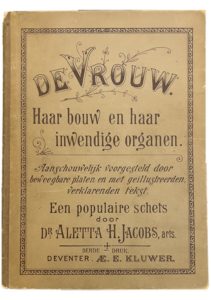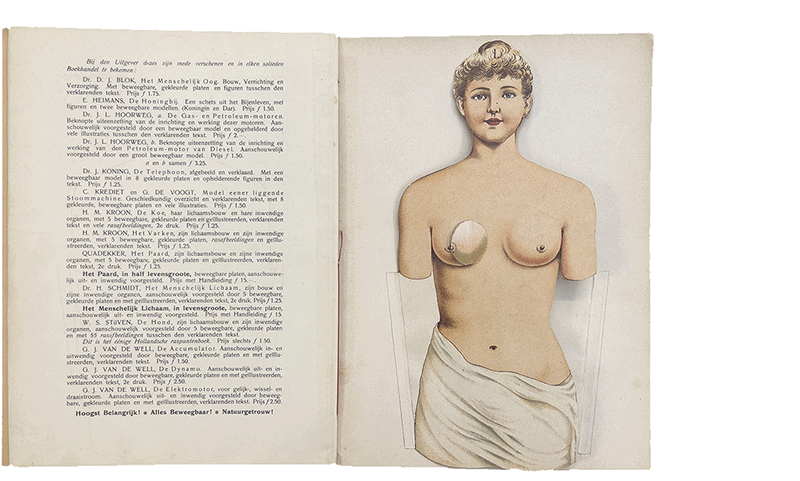
This Women’s History Month, the John Martin Rare Book Room highlights a book from the pioneering 19th-century Dutch physician and activist Aletta Jacobs. Born in 1854 in the Netherlands, Jacobs chafed at the status quo and the limited educational opportunities for women in the Netherlands. She rejected the standard for Dutch girls at the time, “finishing school,” and instead studied at home with her parents.
From a young age, Jacobs was determined to pursue her dream of becoming a doctor like her father. At the time, though, women were barred from higher education. To become a doctor meant that she would have to achieve many firsts for the Netherlands.
She first earned a diploma in pharmacy in 1869. She requested admission to the University of Groningen through a letter-writing campaign by herself and her father. She was finally told to continue her studies for two more years to prepare for the entrance exam. Through this provisional admission, she was able to convince a local high school to allow her to attend classes, becoming the first Dutch woman to attend secondary school.
In 1871, she caught wind of a male student granted admission to the University of Groningen based on his pharmacy diploma. She was granted approval to attend and became the first woman to enroll at the University of Groningen. Despite challenges and resistance from male students and professors, she graduated in 1879, earning her medical degree.
Throughout her career, she was a forceful supporter of social reforms. She was an unyielding advocate for the health of women and children as well as suffrage and international peace. She wrote many articles and books, including De Vrouw: Haar bouw en haar inwendige organen [The Woman: Her physique and her internal organs], a short book about female anatomy.

JACOBS, ALETTA (1854-1929). De vrouw: haar bouw en haar inwendige organen [The Woman: Her physique and her internal organs]. Printed in Deventer by Ebele E. Kluwer, 1900. 26 cm tall.
In 1882, Jacobs founded the world’s first birth control clinic in Amsterdam. She believed that women should have control over their reproductive health. Her clinic provided education and resources about contraception, which was a revolutionary idea at the time.
Not content with the birth control options for women at the time, she created and tested a new diaphragm. Establishing its effectiveness, it became a popular birth control choice for women and eventually was known throughout the English-speaking world as the Dutch Cap.
Jacobs was a strong supporter of women’s right to vote. She began her campaign for suffrage in 1883, challenging the legal barriers that prevented women from participating in politics.
Her efforts contributed significantly to the eventual success of the women’s suffrage movement in the Netherlands, culminating in women gaining the right to vote in 1919.
Jacobs was also involved in international peace movements. She participated in international conferences aimed at promoting peace and disarmament, believing that women’s voices were crucial in these discussions. She argued that women had a unique perspective on peace and should be included in decision-making processes.
De vrouw was written to offer a more thorough and accurate understanding of the female body, highlighting both external features and internal organs through detailed illustrations and explanatory text. It focuses on women’s anatomy, especially the structure and function of the female reproductive system, addressing the significant knowledge gap many women had about their own bodies.
De vrouw begins with a foreword by Jacobs, who expressed concern over the widespread ignorance about women’s bodies, even among the educated. Jacobs aimed to provide a concise and accessible resource to satisfy the public’s curiosity and need for information.
The text aimed to deliver clear descriptions supported by illustrations, stressing the importance of understanding both the general framework of human anatomy and the specific details of female organs. This introduction sets the stage for a detailed exploration of human anatomical structures, emphasizing the need for better education on the subject.
The book is slim in form, with the text block snuggled between two stiff paper boards. The whole thing is held together with a pamphlet-type stitch with a lovely and vibrant red thread. It is chock full of illustrations, including a thorough flap illustration shown in the photo below. The copy in the John Martin Rare Book Room is in stable condition, although, as can also be seen in the image below, the back cover has separated.
Contact Damian Ihrig, curator of the John Martin Rare Book Room, to take a look at this book: damien-ihrig@uiowa.edu or 319-335-9154.
